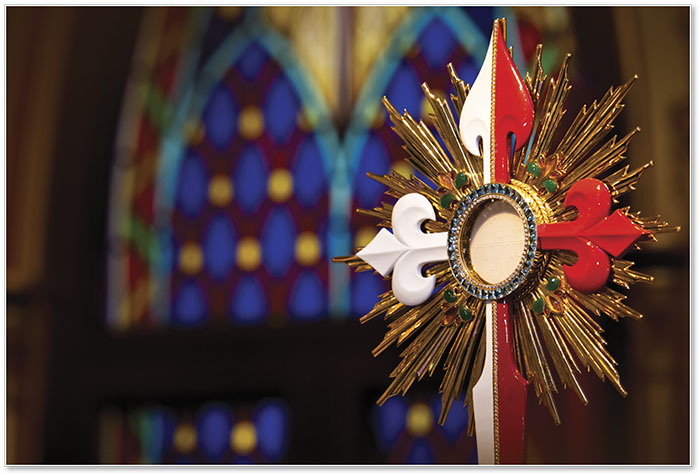Our gaze does not perceive the crystal of the monstrance, but passes through it to adore God hidden under the species of bread. Does this fact have a higher symbolism?
A faint light inside the sacred enclosure invites us to intimacy with God, in recollection and prayer. It comes not from the large basilica, but from an inviting side chapel where we find Jesus in the consecrated Host, exposed for adoration in the monstrance.
The interior of the chapel is dim; only the Blessed Sacrament is illuminated. Reverently, the Church raises her praises in the Gregorian hymn Adoro te devote: “Godhead here in hiding, whom I do adore / Masked by these bare shadows, shape and nothing more / See, Lord, at Thy service low lies here a heart / Lost, all lost in wonder at the God Thou art.”
The liturgical objects of the place harmonize with the ambience, each glorifying, in its own way, the “Living Bread, the life of us,” as expressed in the centuries-old chant. Without wishing to draw attention away from the main focal point, which is Our Lord Jesus Christ, let us examine one of them.
Designed exclusively to display the Sacred Species during the time of adoration, the monstrance acts as an “honour guard” of the Eucharist, enshrining it upon a dignified pedestal to be beheld by the faithful, as they pour out acts of faith, love and confidence. For this sublime function, devotion has dictated the use of precious metals in the fabrication of monstrances – often fine gold or pure silver. Representations of Angels or the twelve Apostles may adorn the piece, turning it into a real work of art! Precious stones certainly have their place, celebrating the King of the Universe with their beauty.

We could further highlight the sunburst, or the lunette designed to hold the consecrated particle in place. However, I would like to emphasize the circular crystal whose transparency allows our gaze to rest on the Sacred Host. It has a certain material dignity of its own, but its symbolism far exceeds any pecuniary value.
The crystal remains very close to the Sacramental Jesus, enclosing and protecting Him. It is indispensable to keep it always clean and translucent so that, under the veils of faith, the adorer may venerate the same Messiah who, during His earthly life in Israel, healed the sick, consoled the downcast, strengthened the weak, raised the dead, chastised the wicked, expelled demons, taught the truth, shed His Blood, destroyed death and redeemed humanity.
Our gaze typically passes through the crystal without noticing it. At most, a reflection of light on its surface may remind us of its existence. But it is there to fulfil a purpose, not to be admired. It seeks no attention; its sole aim is to protect and display the Host while acts of worship are taking place.
Does this fact have any application to our spiritual life?
In one of her poems, St. Therese of the Child Jesus declared: “By your presence, I am a living monstrance.”1 Indeed, those who are baptized and in the state of grace have God dwelling and acting in their soul. In these conditions, like the polished crystal of the monstrance, they become models for their brethren in the Faith, revealing Our Lord Jesus Christ through the good example of virtue. Since the Most High is at work within them, it is this same Author of good that others will see and glorify in them.
Both in the Eucharist and in the soul of the just, we adore the hidden God. For this reason, our above-cited Eucharistic hymn ends with a confident supplication: “O Jesu, whom I look at shrouded here below, I beseech Thee send me what I thirst for so / Some day to gaze on Thee face to face in light / And be blest for ever with Thy glory’s sight. Amen.” ◊
Taken from the Heralds of the Gospel magazine, #176.
1 ST. THERESE OF LISIEUX. The Poetry of Saint Therese of Lisieux. Washington, DC: ICS, 1996, p.286.
